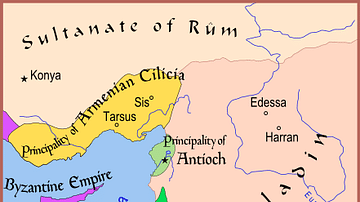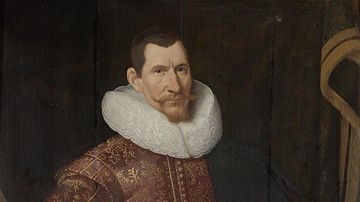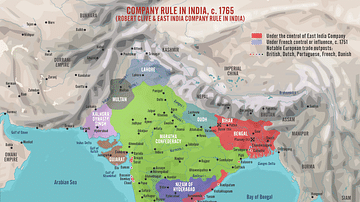Search
Search Results

Definition
Maasai People
The Maasai (or Masai) people are an East African tribe who today principally occupy the territory of southern Kenya and northern Tanzania, and who speak the language of the same name. The Nilo-Saharan Maasai migrated southwards to that region...

Video
History of the English East India Company
Did you know the English East India Company’s tea trade was fueled by the opium trade? The English East India Company (EIC) – also known as the British East India Company – was an immensely successful trading company founded in 1600...

Image
Britannia Receiving the Riches of the East
A 1778 allegorical painting commissioned by the East India Company showing the riches of the East being presented to Britannia. Painted by Spyridon Romas. The goods shown include tea, porcelain, and jewels. (British Library, London)

Image
Ancient Near East c.1500-1300 BCE - The Old Hittite Collapse and the Rise of Kassites, Mitanni, and the New Kingdom of Egypt
This map illustrates the geopolitical landscape of the ancient Near East following the destructive campaigns of the Old Hittite Empire (circa 1650–1500 BCE), which triggered widespread upheaval and realigned regional power structures. In...

Image
Map of The Latin East, 1190 CE
A map of the Middle East showing the Crusader-held Latin East states at the time of the Third Crusade (1189-1192 CE).

Image
East India Docks
An 1808 coloured print showing the docks of the East India Company, known as the East India Docks, at Blackwall in London. (British Museum, London).

Image
Jan Pieterszoon Coen, Governor General of the Dutch East Indies
Jan Pieterszoon Coen (1587-1629), an officer of the Dutch East India Company and twice the company's Governor-General in the Dutch East Indies, oil on wood portrait after Jacob Waben, 1629.
Westfries Museum, Hoorn, The Netherlands.

Image
The Median Empire and the Ancient Near East, c. 600 BCE
A map illustrating the rise and expansion of the Median Empire in the wake of the Bronze Age Collapse and the disintegration of the Neo-Assyrian Empire (c. 609 BCE). While the Neo-Babylonian Empire engulfed the Fertile Crescent from the Levantine...

Image
Robert Clive & The East India Company Rule in India, c. 1765
A map illustrating the transformation of the East India Company from a hopeful merchant venture in 1600 with isolated trade outposts governed by isolated and mostly independent town councils into a major ruler of large territories in India...

Image
The Ancient Near East, c. 1300 BCE - On the Eve of Collapse: Power and Politics in the Late Bronze Age
This map illustrates the shifting political landscape of the Ancient Near East in the 13th century BCE, a period marked by the rise of imperial powers and the decline of older kingdoms. The expansion of the Hittite and Assyrian empires redrew...